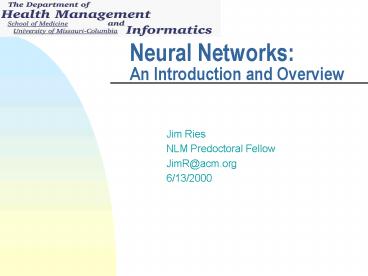Neural Networks: An Introduction and Overview PowerPoint PPT Presentation
1 / 19
Title: Neural Networks: An Introduction and Overview
1
Neural Networks An Introduction and Overview
- Jim Ries
- NLM Predoctoral Fellow
- JimR_at_acm.org
- 6/13/2000
2
Introduction
- Provide an intuitive feel for what NNs are and
problems for which they are an appropriate tool. - NOT overwhelm you with mathematics.
- Caveat Im not an NN researcher just an
interested outsider (like most of you).
3
Topics of Discussion
- What are Neural Networks?
- Training
- History
- Alternative Methods
- Applications
- Conclusions
- Questions
4
What are Neural Nets?
- A mechanism for approximating a function, given
some sample or training data. - A mechanism for classifying, clustering, or
recognizing patterns in data. - These two broad applications are essentially the
same (e.g., imagine a function that outputs a
discrete number indicating a cluster).
5
What are Neural Nets? (cont.)
- Rosenblatts Perceptron a network of processing
elements (PE)
Y1
Yp
a1
am
. . .
x1
x2
x3
xn
. . .
6
What are Neural Nets? (cont.)
- Additional layer(s) can be added
Y1
Yp
a1
am
. . .
h1
hm
. . .
x1
x2
x3
xn
. . .
7
What are Neural Nets? (cont.)
8
What are Neural Nets? (cont.)
- A node (PE) is typically represented as a
function. - Simple functions can quickly be trained or
updated to fit a curve to data, but are unable to
fit well to complex data (e.g., linear functions
can never approximate quadratics). - Universal Approximator! (typically Radial Basis
Function).
9
Training
- With simple Perceptron model, we can train by
adjusting the weights on inputs when the output
does not match test data. - The amount of adjustment we do at each training
iteration is called the learning rate.
10
Training (cont.)
- With one or more hidden layers, training requires
some sort of propagation algortihm. - Backpropagation is commonly used and is an
extension to the Minimum Disturbance Algorithm
11
Training (cont.)
- Minimum Disturbance Algorithm
- 1) Apply an example, propagate inputs to output
- 2) Count of incorrect output units
- 3) For output units, do a number of times
- Select unselected units closest to zero
activation - Change weights
- if less errors, use new weights, else old
- 4) Repeat step 3 for all layers
12
Training (cont.)
- Overfitting - fits a function to training data,
but does not approximate real world. - Ways to avoid overfitting
- Regularization (assumes real function is
smooth. - Early stopping
- Curvature-driven
13
History
- Early 1960s - Rosenblatts Perceptron
(Rosenblatt, F., Principles of Neurodynamics, New
York Spartan Books, 1962). - Late 1960s - Minsky (Minsky, M. and Papert, S.,
Perceptrons, MIT Press, Cambridge, 1969). - 1970s early 1980s - largely empty of NN
activity due to Minsky.
14
History (cont.)
- Late 1980s - NN re-emerge with Rumelhart and
McClelland (Rumelhart, D., McClelland, J.,
Parallel and Distributed Processing, MIT Press,
Cambridge, 1988). - Since PDP there has been an explosion of NN
literature.
15
Alternative Methods
- Classical statistical methods
- Fail in on-line scenarios
- Not universal approximators (e.g., linear
regression) - Assume normal distribution.
- Symbolic approach.
- Expert Systems
- Mathematical Logic (e.g., Prolog)
- Schemas, Frames, or Scripts
16
Alternative Methods (cont.)
- NNs are the Connectionist approach.
- Encoding of data can be a creative endeavor
- Ensemble Approach
- Baysian Networks
- Fuzzy NN
17
Applications
- Control
- Forecasting
- Provide faster approximations compared to exact
algorithms (e.g., NeuroBlast). - Compression
- Cognitive Modeling
18
Conclusions
- NNs are useful for a wide variety of tasks, but
care must be taken to choose the correct
algorithms for a given problem domain. - NNs are not a panacea, and other approaches may
be appropriate for given problems.
19
Questions?

